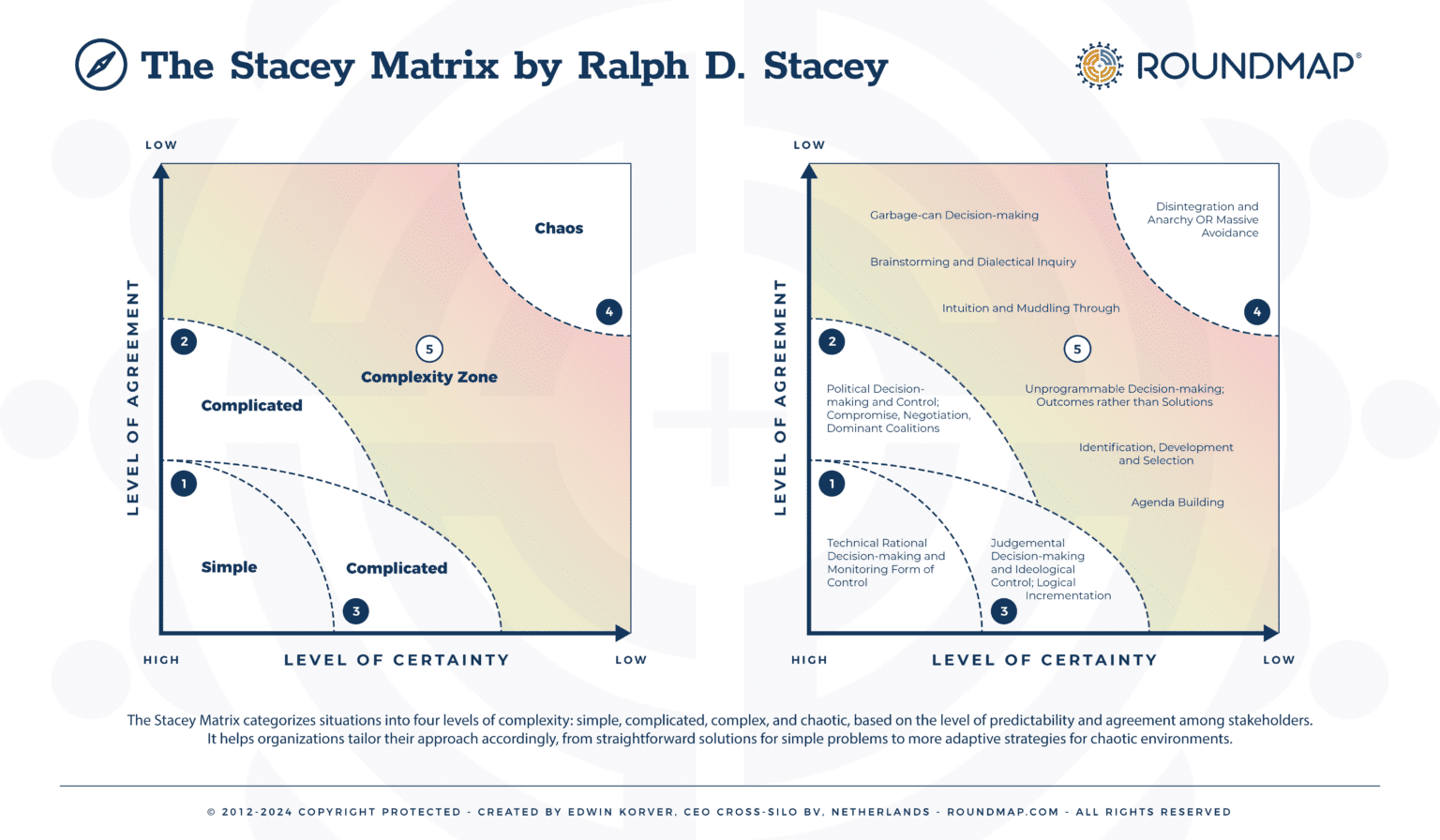In the realm of organizational development and strategic management, the transition from conventional linear approaches to a more integrated, holistic perspective has been both necessary and inevitable. At the forefront of this evolution stands Ralph Stacey’s pioneering work on complex adaptive systems (CAS) and the Stacey Matrix, alongside RoundMap’s visionary approach to whole-system thinking. Together, they offer a comprehensive blueprint for navigating the complexities of the modern business landscape.
Complex Adaptive Systems and the Stacey Matrix
Ralph Stacey’s concept of CAS and the Stacey Matrix illuminate the intricate dynamics that characterize organizations and their environments. Complex adaptive systems (CAS), with their capacity for self-organization, adaptation, and emergent behavior, defy the predictability of deterministic systems. Instead, they exhibit stochastic, or non-deterministic, qualities where probabilities rather than certainties influence outcomes. This shift in understanding from linear to non-linear dynamics challenges us to reconsider our organizational strategy and decision-making approaches.
The Stacey Matrix, a tool developed by Stacey, further elucidates the relationship between the degree of certainty and agreement within organizations. It categorizes challenges into simple, complicated, complex, and chaotic domains, guiding leaders in applying appropriate strategies based on the nature of the issues.
Applying the Stacey Matrix
To understand the practical use of the Stacey Matrix, it’s essential to understand the four quadrants:
- Simple: High certainty and agreement on what to do. Tasks are well-understood and predictable.
- Complicated: Some degree of uncertainty or need for expertise, but still a high level of agreement on the outcomes.
- Complex: High uncertainty with diverse viewpoints, making the outcomes unpredictable.
- Chaotic: Neither certainty nor agreement exists on what to do, leading to high ambiguity.
Practical Application
Imagine a tech company planning to develop a new software product. Given the diverse challenges and uncertainties, the leadership team is assessing how to approach this project.
Step 1: Assessing the Project Using the Stacey Matrix
- Requirement Gathering: Initially, the project may fall into the Simple quadrant, where the team agrees on basic functionalities and clear customer needs.
- Technical Architecture Planning: As they delve into technical architecture, the project might move into the Complicated quadrant. Expert opinions and technical knowledge become crucial, though the goal remains clear.
- Market Fit and User Feedback: Entering the development phase, especially when adjusting the product based on market feedback, the project shifts to the Complex quadrant. Predicting market response and aligning it with the product becomes challenging, with varying opinions and uncertain outcomes.
- Crisis Management: Suppose a significant, unforeseen market shift occurs or a critical technical flaw is discovered late in development. The project is now in the Chaotic quadrant, where immediate, innovative solutions are required without a clear path forward.
Step 2: Applying Strategies Aligned with the Matrix
- Simple: Apply best practices and standard procedures. Routine decision-making processes are sufficient.
- Complicated: Utilize expert analysis and predictive models. Planning and structured methodologies dominate.
- Complex: Foster open dialogue, conduct experiments, and use iterative development to explore various outcomes. Agile methodologies and stakeholder feedback are vital.
- Chaotic: Implement rapid response teams, brainstorm innovative solutions, and be ready to take decisive action without a predefined roadmap. Flexibility and adaptability are crucial.
Step 3: Adapting and Evolving
As the project progresses, its position in the Stacey Matrix may change, requiring leaders to adapt their strategies accordingly. Continuous reassessment is essential to ensure that the management approach aligns with the current level of uncertainty and agreement.
From Deterministic to Dynamic
In a deterministic system, predictability and control are the underlying assumptions. However, the reality of business ecosystems is far from this static ideal. They are dynamic systems characterized by continuous change, where linear cause-and-effect relationships no longer suffice. This realization paves the way for embracing non-linear systems, where feedback loops, interdependencies, and the potential for sudden, profound changes demand a more flexible, adaptive approach.
Emergence and Adaptation
Emergence, a hallmark of complex adaptive systems, refers to the spontaneous creation of order and novel structures out of chaos. This principle of emergence underpins the innovative and adaptive capabilities of organizations, enabling them to navigate uncertainties and capitalize on opportunities in a fluid environment.
Integrating Whole-System Thinking with CAS
RoundMap’s commitment to whole-system thinking resonates deeply with the insights from complexity science and Stacey’s frameworks. By advocating for stakeholder-driven leadership, cyclical operations, and a departure from siloed thinking, RoundMap® embodies the principles of CAS, fostering an environment where continuous learning, adaptability, and collaborative empowerment thrive.
Our holistic approach acknowledges the inherent complexity and dynamism of business ecosystems and leverages these characteristics to drive sustainable innovation and growth. By integrating systems thinking, stakeholder engagement, and a purpose-driven ethos, we unlock organizations’ collective potential, propelling them toward a future where adaptability and interconnectedness define success.
Conclusion: A Unified Path Forward
The synergy between Ralph Stacey’s exploration of complex adaptive systems and RoundMap’s whole-system transformation offers a powerful paradigm for organizations seeking to thrive amidst complexity. As we move forward, integrating these perspectives will continue to inspire and guide leaders toward embracing the unpredictable, fostering resilience, and achieving collective success in an ever-evolving world.
Author
-
Edwin Korver is a polymath celebrated for his mastery of systems thinking and integral philosophy, particularly in intricate business transformations. His company, CROSS-SILO, embodies his unwavering belief in the interdependence of stakeholders and the pivotal role of value creation in fostering growth, complemented by the power of storytelling to convey that value. Edwin pioneered the RoundMap®, an all-encompassing business framework. He envisions a future where business harmonizes profit with compassion, common sense, and EQuitability, a vision he explores further in his forthcoming book, "Leading from the Whole."


